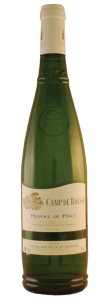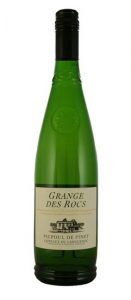Tasting Notes
 Emma says: “I guess there had to be a week. To date I’ve been able to wax lyrical about pretty much every wine we’ve tasted and often enjoyed the opportunity to revisit an old grape friend I’d forgotten.
Emma says: “I guess there had to be a week. To date I’ve been able to wax lyrical about pretty much every wine we’ve tasted and often enjoyed the opportunity to revisit an old grape friend I’d forgotten.
I thought this grape would be the same, as it is one of those grapes that wine people say is due a revival. I’ve seen other French native grapes like Picpoul rise to the top of wine lists and wondered why Muscadet hasn’t been given the same nudge forward. After all, in its heyday it was almost as well known as Sauvignon Blanc, if you have parents who hung out in wine bars in the 1970s and 80s I’m sure they’ll confirm that. Maybe that is why it fell out of fashion, it became that drink “your parents like”.
I’ve also heard whispers that the demise of the Muscadet region was also due to lots of grape growers cashing in during its era of popularity and producing high yielding grapes with flavours close to water. That era is well over because nowadays Muscadet producers are more likely to be shutting up shop due to low consumer demand; especially after a long run terrible harvests which drove many of them out of business. So as the going says “only the strong survive” which should mean the remaining growers are going to be quality focused and passionate about continuing on their tradition.
Back to the wine. If you are a fan of wines with fruit that springs from the glass then be warned, this may not be for you. The aroma of Muscadet Sur lie is far from it; for me it is always the smell of a sea shore mixed with a herbal and flinty mineral tinge. And to taste if you are an avid seafood fan then you should be getting some of those familiar salty saline flavours with a light citrus bite; limey and slightly pithy. Oysters and Muscadet must be the perfect wine match for this reason. The “sur lie” bit is interesting. Lie or “lees” are the dead yeast cells that go through a process called “autolysis” when in long contact with wine. It creates the biscuity, nutty richness in Champagne and conveys a similar but more delicate flavour to Muscadet. It is also quite helpful to soften our the potential sharpness of a high acid, cool climate wine. Many white wines use “lees” for this reason, unoaked Chardonnay like a good Macon Villages has that roundness and texture for the same reason.
But I’m afraid my experience of Muscadet this time just didn’t float my boat. It made me think about how you reach out for a glass of something that suits your mood. And the night before I had bought a bottle of Macon because I wanted something with that smooth, soft peachy flavour which that gives me. I had my glass of Muscadet straight after that and it just seemed a little weak and lacking flavour as a result. Perhaps another night, a different mood and it would have been more interesting to me. After all I have tried some incredible aged Muscadet in the past that had made me remember it as more special wine.”
Andy says: “I sort of tasted this wine three times, and had three different opinions about it.
The first time was with dinner, and not with one of the recommended matches – a spicy five bean chilli. However, it seemed a perfect match to me. The wine was fruity, cool, crisp, cutting through the chilli with so much ease the glass didn’t last long at all.
The second glass, and therefore tasting, wasn’t far behind. But this time, as the chilli wore off and my palate neutralised, I liked it much less, finding it to be quite sour and limey.
The third tasting was a day or so later, and it was a similar experience. Initially I liked it when cool and out of the fridge, but I then forgot about it for about 20 mins. Tasting it slightly warmer and it was back to the sour limey version. So I guess the lesson here, for me at least, is that it how wine is served/consumed really does make a difference.”
Buying Guide
This week’s grape is more commonly known as Muscadet, which is a region in the Loire area of France. It has fallen out of fashion but is a lovely dry white. We are going to try a specific style called “Muscadet Sur Lie”. We’ll explain what that means later, but for now find the French white section and look for those words on the front label. It should be widely available.


 Emma says: “Today was equal pleasure and pain when it comes to the 52grapes experience. Arriving home late from a work trip, we realised tonight was the only night we had to try a Fiano before our weekly newsletter deadline.
Emma says: “Today was equal pleasure and pain when it comes to the 52grapes experience. Arriving home late from a work trip, we realised tonight was the only night we had to try a Fiano before our weekly newsletter deadline.
 Emma says: “After a full on gutsy red last week this wine really is ringing the changes. The choice of a South African Chenin may be a bit controversial to those who love the versions from its birthplace the Loire. I wanted to give a nod to South Africa because I think they are producing increasingly interesting versions of Chenin in their own particular style.
Emma says: “After a full on gutsy red last week this wine really is ringing the changes. The choice of a South African Chenin may be a bit controversial to those who love the versions from its birthplace the Loire. I wanted to give a nod to South Africa because I think they are producing increasingly interesting versions of Chenin in their own particular style.
 Emma says: “The 52 grape challenge has hit new heights this week. I sit here with my chilled glass of Picpoul but it should be a Chardonnay because I’m as lonely and sad as Bridget Jones.
Emma says: “The 52 grape challenge has hit new heights this week. I sit here with my chilled glass of Picpoul but it should be a Chardonnay because I’m as lonely and sad as Bridget Jones. dry, and well, a little rough. I think ‘rustic’ is the term. There was a bit of a burn, and it felt more than the 12.5% on the label. I sensed a little tingle on the tongue, which initially I thought was CO2, but after a few sips more I decided it wasn’t and that the wine was ‘as flat as a pancake’.
dry, and well, a little rough. I think ‘rustic’ is the term. There was a bit of a burn, and it felt more than the 12.5% on the label. I sensed a little tingle on the tongue, which initially I thought was CO2, but after a few sips more I decided it wasn’t and that the wine was ‘as flat as a pancake’.





 Emma says: “OK, I admit it. This whole 52 grape thing has got me overexcited. This week I realised it was the perfect excuse to go back to buying wines I’ve never tasted from an eclectic mix of stores. Just like I used to do before wine become my job.”
Emma says: “OK, I admit it. This whole 52 grape thing has got me overexcited. This week I realised it was the perfect excuse to go back to buying wines I’ve never tasted from an eclectic mix of stores. Just like I used to do before wine become my job.”